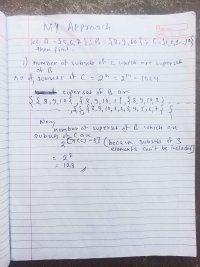Let A={5,6,7} ; B = {8,9,10} C = {1,2,3,4,5,6,7,8,9,10} then find
(i) number of subsets of C which are supersets of B.
(ii) number of subsets of C having number of element of A and B.
(iii) number of subsets of C having exactly one element from each of A and B.
(i) number of subsets of C which are supersets of B.
(ii) number of subsets of C having number of element of A and B.
(iii) number of subsets of C having exactly one element from each of A and B.

